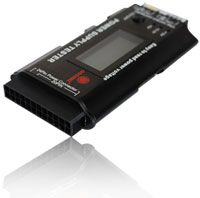LCD Power Supply Tester (PS-228) FAQ
How can i purchase the PS-228?

Pricing and product details can be found on the PS-228 product page.
How should I get started?
We highly recommend that users get started by reading page 8 in the PassMark PCI POST Card Professional User Manual, "3. Getting Started". This section explains safety precautions and provides a walkthrough of the correct testing procedure. The online download link for this manual was provided with your purchase, but it is also available from the PassMark UFD in the Documents and Guides folder.
Why isn't the Power Supply Tester working?
First, check that the main PC power connector is firmly plugged into the right port on Power Supply Tester as well as any other power connectors you wish to test. If the main PC power connector isn't connected properly, the unit will fail to turn on. Next, ensure that the Power Supply Unit (PSU) has been plugged in correctly and is switched on (note: not all models of PSUs have a power switch) before pressing the button on the front of the tester. If you are still encountering problems, please refer to the PassMark Power Supply User Manual or contact us for further support.
How many power connectors can I safely plug into the Power Supply Tester at once?
Including the main power connector, never plug in more than three power connectors simultaneously for safety reasons. While testing with the LCD power supply tester is relatively safe compared to other test methods, we strongly recommend adhering to safety guidelines on page 11 of the User Manual to minimize risk.
How long do I need to test my Power Supply Unit (PSU)?
It should only take a few seconds to effectively test a PSU for faults using the Power Supply Tester. In no circumstance should power connectors be tested for more than fifteen seconds. At the very least, continuous testing may overheat and damage your LCD Power Supply Tester.
Why aren't the green LEDs lighting up?
This is normal behaviour for some power connectors, as not all connectors have all voltages. The only time in which the LEDs will be lit is when a SATA, Molex or Mini-Molex power connector has been plugged into the LCD Power Supply Tester in conjunction with the main PC power connector. More information on the LEDs and Voltage Line Colors can be found in the User Manual in the Reference Section.
What do the numbers on the LCD display mean?
Generally, the numbers on the LCD display indicate the level of voltage on the main power connector. The +12V2 reading displays the voltage on the +12V2 rail, which is only present on the P4, PCI-Express (6-pin or 8-pin) or 8-pin power connector. Where none of these connectors are plugged into the device, it is normal for no reading to be displayed. For more information on normal voltage ranges, please refer to page 6 of the User Manual.
What does "PG" in the LCD display mean?
PG stands for Power_Good, also known as "Power OK". This signal is an indication to the motherboard from the PSU that power is stable and ready to use, preventing the computer from starting ahead of time and potentially damaging components. The LCD displayl indicates how long it takes to receive the Power_Good signal from the PSU in milliseconds.
Why is the Power Supply Tester beeping?
The LCD Power Supply Tester will beep continuously when it detects a power defect within the current circuit. Power defects that the power supply tester will alert you to include a missing voltage, over-voltage or under-voltage on power rails. Please refer to the User Manual for nominal rail voltages and voltage fluctuation information.
Where can I get the User Manual?
The URL for the LCD Power Supply Tester (PS-228) User Manual was provided as part of your hardware shipment from PassMark. If you purchased the PC Test Kit, it will also be available in the Documents and Guides folder on the PassMark UFD. If you've otherwise misplaced the URL, please contact us with your purchase details and we will forward you the latest copy of the User Manual.
My device doesn't look exactly like the one in the image above ?
You might have the superseded PS-224 model. But Coolmax also released several versions of the PS-228 device. Initially they had an black anodized aluminum case, but later production runs switched to plastic cases as the price of aluminum increased. There are also variations in the printing with some runs have embossed writing and others having white printed text. All variants are identical in function however.